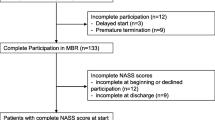Abstract
Purpose
The influence of individual factors on patient-reported outcomes is important in the interpretation of disability and treatment effectiveness. The purpose of this study was to assess how physical impairments, psychosocial factors, and life style habits were associated with neck disability based on the Neck Disability Index (NDI), in patients with cervical radiculopathy scheduled for surgery.
Methods
This cross-sectional study included 201 patients (105 men, 96 women; mean age 50 years). Data included self-reported measures and a clinical examination. Multiple linear regressions were performed to identify significant influencing factors.
Results
Pain, physical impairments in the cervical active range of motion, low self-efficacy, depression, and sickness-related absences explained 73 % of the variance in NDI scores (p < 0.001).
Conclusion
Assessments of physical impairments and psychosocial factors in patients with cervical radiculopathy could improve the description of neck disability and the interpretation of treatment outcomes in longitudinal studies.
Similar content being viewed by others
References
Löfgren H, Johansen F, Skogar O, Levander B (2003) Reduced pain after surgery for cervical disc protrusion/stenosis: a 2 year clinical follow-up. Disabil Rehabil 25:1033–1043
Peolsson A, Vavruch L, Öberg B (2002) Disability after anterior decompression and fusion for cervical disc disease. Adv Physiother 4:111–124
Peolsson A, Kjellman G (2007) Neck muscle endurance in nonspecific patients with neck pain and in patients after anterior cervical decompression and fusion. J Manip Physiol Ther 30:343–350
Hermansen A, Hedlund R, Vavruch L, Peolsson A (2011) A comparison between the carbon fiber cage and the Cloward procedure in cervical spine surgery: a 10–13 year follow-up of a prospective randomized study. Spine 36:919–925
Engquist M, Löfgren H, Öberg B, Holtz A, Peolsson A, Soderlund A, Vavruch L, Lind B (2013) Surgery versus non-surgical treatment for cervical radiculopathy: a prospective, randomized study comparing surgery plus physiotherapy with physiotherapy alone with a two year follow-up. Spine 38:1715–1722
McCormick JD, Werner BC, Shimer AL (2013) Patient-reported outcome measures in spine surgery. J Am Acad Orthop Surg 21:99–107
Bono CM, Ghiselli G, Gilbert TJ, Kreiner DS, Reitman C, Summers JT, Baisden JL, Easa J, Fernand R, Lamer T, Matz PG, Mazanec DJ, Resnick DK, Shaffer WO, Sharma AK, Timmons RB, Toton JF (2011) An evidence-based clinical guideline for the diagnosis and treatment of cervical radiculopathy from degenerative disorders. Spine J 11:64–72
Peolsson A, Vavruch L, Öberg B (2006) Predictive factors for arm pain, neck pain, neck specific disability and health after anterior cervical decompression and fusion. Acta Neurochir 148:167–173
Peolsson A, Peolsson M (2008) Predictive factors for long-term outcome of anterior cervical decompression and fusion: a multivariate data analysis. Eur Spine J 17:406–414
Peolsson A, Hedlund R, Vavruch L, Öberg B (2003) Predictive factors for the outcome of anterior cervical decompression and fusion. Eur Spine J 12:274–280
Vernon H (2008) The neck disability index: state-of-the-art, 1991–2008. J Manip Physiol Ther 31:491–502
Huskisson EC (1974) Measurement of pain. Lancet 2:1127–1131
Wainner RS, Fritz JM, Irrgang JJ, Boninger ML, Delitto A, Allison S (2003) Reliability and diagnostic accuracy of the clinical examination and patient self-report measures for cervical radiculopathy. Spine 28:52–62
Peolsson A, Almkvist C, Dahlberg C, Lindqvist S, Pettersson S (2007) Age- and sex-specific reference values of a test of neck muscle endurance. J Manip Physiol Ther 30:171–177
Jensen IB, Linton SJ (1993) Coping strategies questionnaire (CSQ): reliability of the Swedish version of the CSQ. Scand J Behav Ther 22:139–145
Hirsh AT, George SZ, Riley JL 3rd, Robinson ME (2007) An evaluation of the measurement of pain catastrophizing by the coping strategies questionnaire. Eur J Pain 11:75–81
Altmaier EMRD, Kao CF, Lehmann TR, Weinstein JN (1993) Role of self-efficacy in rehabilitation outcome among chronic low back pain patients. J Couns Psychol 40(3):335–339
Iles RA, Davidson M, Taylor NF, O’Halloran P (2009) Systematic review of the ability of recovery expectations to predict outcomes in non-chronic non-specific low back pain. J Occup Rehabil 19:25–40
Cherkin DC, Deyo RA, Street JH, Barlow W (1996) Predicting poor outcomes for back pain seen in primary care using patients’ own criteria. Spine 21:2900–2907
Zung WW (1965) A self-rating depression scale. Arch Gen Psychiatry 12:63–70
Main CJ (1983) The modified somatic perception questionnaire (MSPQ). J Psychosom Res 27:503–514
Field A (ed) (2009) Discovering statistics using SPSS for windows, 3rd edn. SAGE Publications, London
Saavedra-Hernandez M, Castro-Sanchez AM, Cuesta-Vargas AI, Cleland JA, Fernandez-de-las-Penas C, Arroyo-Morales M (2012) The contribution of previous episodes of pain, pain intensity, physical impairment, and pain-related fear to disability in patients with chronic mechanical neck pain. Am J Phys Med Rehabil 91:1070–1076
Thompson DP, Urmston M, Oldham JA, Woby SR (2010) The association between cognitive factors, pain and disability in patients with idiopathic chronic neck pain. Disabil Rehabil 32:1758–1767
Young SB, Aprill C, Braswell J, Ogard WK, Richards JS, McCarthy JP (2009) Psychological factors and domains of neck pain disability. Pain Med 10:310–318
Acknowledgments
The authors acknowledge financial support from The Swedish Research Council, The Swedish Society of Medicine, and the Medical Research Council of Southeast Sweden, and thank Henrik Magnusson and Karl Wahlin at the University of Linköping in Sweden for their help with the statistics.
Conflict of interest
None.
Author information
Authors and Affiliations
Corresponding author
Rights and permissions
About this article
Cite this article
Wibault, J., Öberg, B., Dedering, Å. et al. Individual factors associated with neck disability in patients with cervical radiculopathy scheduled for surgery: a study on physical impairments, psychosocial factors, and life style habits. Eur Spine J 23, 599–605 (2014). https://doi.org/10.1007/s00586-013-3066-0
Received:
Revised:
Accepted:
Published:
Issue Date:
DOI: https://doi.org/10.1007/s00586-013-3066-0




